 By Staff
By Staff
February 2nd, 2024
BURLINGTON, ON
Wiarton Willie predicts an early Spring.
Did we have a winter?

Didn’t see his shadow – early Spring predicted.
.

|
|
||||||||
|
February 2nd, 2024 BURLINGTON, ON
Burlington Teen Tour Band, Canada’s oldest and largest youth marching band, is set to delight audiences locally and overseas this spring. The Burlington Teen Tour Band will have their spring concert April 7 and have been invited to participate in the 80th D-Day Anniversary Tour in England and France May 31 – June 10. These performances not only mark a thrilling chapter for the band but are also bolstered by the announcement of new Burlington Teen Tour Band Director of Bands & Music Services Roberto (Rob) Cuesta. Roberto (Rob) will begin in his new role on Feb. 20, 2024, as the creative force behind Burlington’s globally renowned marching band. About Burlington Teen Tour Band Director Roberto Cuesta Roberto (Rob) Cuesta Roberto (Rob) brings over 28 years of experience in band and music services to the Burlington Teen Tour Band. He is a seasoned musician, marketer and business leader obtaining his Master of Business Administration with Distinction from Warwick Business School and a Postgraduate Diploma in Marketing from the UK Chartered Institute of Marketing. Roberto (Rob) has 18 years of youth work experience beginning with Scouts Canada and then Air Cadets which lead him to progressive leadership roles in both areas and an appointment as Band Master at an early age. By age 23, he became Director of Music running a band with 75 per cent of members under age 21 and later became National Training Director for the Traditional Youth Marching Band Association (TYMBA). Most recently, Roberto (Rob) was Director of Music for the 48th Highlanders of Canada. He has ten years of experience as a Band Leader and an additional 14 years as a player in military-style wind bands such as: The Queen’s Own Rifles of Canada, The Governor General’s Horse Guards and The Band of the Hampshire Constabulary to name just a few.  The Family Lobby: Burlington Teen Tour Band marches into the space with every instrument blaring away. It was a great day for BPAC and the day the BTTB made the place their home base. Annual Spring Concert Featuring: Burlington Teen Tour Band and Junior Redcoats Date: April 7, 2024 Time: Two ticketed performances at 2 p.m. and 7 p.m. Tickets: To purchase tickets, contact Burlington Performing Arts Centre (BPAC) box office Burlingtonpac.ca/Burlington-teen-tour-band. Location: BPAC in Burlington 80th D-Day Anniversary TourFeaturing: Burlington Teen Tour Band Dates: May 31 – June 10, 2024 Background: The Mayor of Courseulles-sur-Mer sent a personal invitation to the Burlington Teen Tour Band to attend the 80th Anniversary of D-Day. The band has taken part in past D-Day anniversary events including the 40th, 50th, 60th and 75th. The 80th anniversary may be the last large scale anniversary event to commemorate this historic event as the veterans who took part are becoming fewer and fewer. A tour like this is unique as it is by invitation only. The educational value is incredible with the opportunity to speak with the veterans directly and visit the Canadian war cemetery.  Last major tour took the Teen Tour Band to Ireland
About Burlington Teen Tour BandThe Burlington Teen Tour Band have been Canada’s Musical Ambassadors since 1947. They have developed a rich history over the last 75 years. Since its beginnings in 1947, the Burlington Teen Tour Band has grown into Canada’s oldest and largest youth marching band. The Burlington Teen Tour Band is known globally for its level of excellence in music and marching. They have had the honour and privilege to represent Burlington, Ontario, and Canada around the world in such countries as: England, Republic of Ireland, France, Japan, The Netherlands, Belgium, and Germany. The Burlington Teen Tour Band regularly returns home to Burlington as champions or first prize winners from internationally scaled competitions. The Burlington Teen Tour Band travels the world representing Burlington, Ontario, and Canada. The band has performed for Heads of State and Royalty as well as been in television and movies. They have also performed at prestigious events such as the: Rose Bowl Parade, D-Day Anniversary, Orange Bowl Parade, 70th Anniversary of Pearl Harbour, and many more. Burlington Teen Tour Band is open to youth aged 13 to 21 who want to represent Canada as musical ambassadors. Links and Resources
February 2nd, 2024 BURLINGTON, ON
Mobile technology has effectively given consumers a computer in their pocket or, for real tech lovers, tech that can be worn on a wrist or embedded in another peripheral. There are myriad reasons why we all love our mobile phones, but connectivity, security, and the sheer scale of options available to users are undoubtedly among the reasons that people have an interdependent relationship with their phone, tablet, or other smart device.  App revenue is going from strength to strength. Most of us access the vast majority of information on our smartphones through apps rather than via web browsers, and in Canada, they are increasingly popular. In a time of economic slowdowns and external pressure on finances, app revenue is going from strength to strength. Unlike many other sectors, there seems to be no shrinkage of the market here. Initially, market analysts wondered if this was another market boosted by the COVID-19 effect. While some sectors like hospitality and airlines saw massive contractions in the period, other online businesses saw their businesses really take off. The value of the app sector rose from $1.6 billion in 2019 to $2.8 billion in 2021. With so many people restricted to their homes, this could have been expected. However, as the world returned to normal, the sector remained buoyant, and while revenue was down to $2.7 billion in 2022, it is significantly larger than it was pre-pandemic.  The growth is meeting a demand. Statistics show that in January 2023, Canada had 31.2 million smartphone users and apps were downloaded 1.2 billion times. In 2022, the average Canadian spent 4.6 hours on their mobile device daily, up from 1.4 hours in 2019. Social media makes up for a considerable amount of time passed on our mobile phones, but this landscape is constantly changing. Where Facebook once dominated, TikTok became the most downloaded app in 2022. It was not just the most popular social media app but the top-grossing app in Canada overall. TikTok generated $43.6 million and recorded 4.4 million downloads. However, people are not only spending all their screen time on social media. Gaming apps are also top-rated. The first gaming app to go viral was, arguably, Flappybird. Forbes magazine even described it as the Justin Beiber of gaming apps, and at the height of its popularity, it was raking in $50,000 a day. While no other game has since captured the collective imagination in such a way, Roblox has been a firm favourite for many years. In 2022, the app was downloaded almost 55,000 times for Android devices alone. However, according to statistics, the most popular Android app game in 2022 was Stumble Guys, which clocked up an impressive 198,758 downloads.  Canadians love to have a flutter; recent poll revealed over half of the population claimed to have gambled within the last month. Gaming apps are not child’s play. The audience for games on smartphones crosses all demographics. Even people you would not traditionally think of as gamers find a few minutes every morning to battle with the New York Times puzzle app and pit their wits against The Daily Crossword, Wordle and the app’s latest title, Connections. Wordle players are 51% female, 47% male and 2% non-binary. A poll of American Wordle players found more than half of them were Millennials; a quarter were Gen Xers, and the balance were Gen Zs and Baby Boomers. Mobile gambling and casinos are another sector where apps have captured the public’s imagination. Canadians love to have a flutter and a recent poll revealed over half of the population claimed to have gambled within the last month. There are over 19 million active online gambling accounts in the country, and the sector has been boosted by Ontario opening its fully regulated commercial market, making all forms of gambling in the province legal. Whether players choose online slots, poker, roulette or other casino games, a wide selection of apps exist. If you talk about the best casino apps for real money, Spin Casino is the one, so writes Hannah Cutajar from Casino.org. Jackpot City and Play Ojo also score very highly for excellent game selection, chances to earn cashback on every bet and the sheer size of their jackpots. As well as catching up on socials and playing games, there are also more serious uses of apps on mobile devices. Banking and payment apps are also up there with the most downloaded and used apps. There was considerable reticence around online banking security when the concept was first mooted, but improved safety protocols have removed much of these earlier fears. 87% of consumers use their banking app at least once a month. While millennials are the most frequent users, accessing bank accounts using mobile apps is prevalent from Boomers to Gen Zers.  Unique to the Canadian market. The apps that have skyrocketed in usage in recent years are e-wallets, including ApplePay, GooglePay, PayPal and the like. Many people now do not even consider taking a plastic card or cash with them on a night out or a trip into town to buy a meal at their favourite bar or restaurant. Everything they need is on their phone. No wallet full of dollar bills, just a charged-up phone, and they can pay for everything with a tap and a little bit of face recognition wizardry. Canadians are also fond of using Interac e-transfers to move money around. This service allows them to send and receive money instantly after registering with an email address or mobile phone number. It is so familiar to Canadians that it is sometimes surprising to remember that it is unique to the Canadian market.  Apps are leading the way in accessing information. Apps are used for every walk of life. You can book a holiday through Airbnb and check the weather in your hometown or on the other side of the world. Video and music streaming apps are now how we expect to access films and TV shows or listen to our top music artists and podcasts. If we do not know what song is playing, we can switch to Shazam to get the artist’s name, song title and lyrics. Apps are the key to endless entertainment and information, and we have not even brushed on retail opportunities in this article. If there is something you want to do on your mobile, the chances are someone will have created an app for it.

February 1st, 2024 BURLINGTON, ON
To start, the current event at the Performing Arts Centre Community Theatre has had sold out in performances in Toronto and New York City and won the top prize in the drama category for the 2023 Governor General’s 2023 Literary Awards. As You Like It – that Land acknowledgement It was not a performance – it was an experience that everyone should have but, like cod liver oil – good for you but.  We want the land back. Cliff Cardinal spends 90 minutes on a platform literally hammering his audience who at times became part of what he was saying. The dialogue between Cardinal and about six people ended up with their walking out which was punctuated with f bombs being dropped all over the place. The message was: Forget your lands acknowledgements, they are phony balony anyway – “we want our land back.” Roseland was the target. From time to time an event is put on at the Performing Arts Centre that I want to review. Most of the time performances are for two days, often just one – which doesn’t give me much time to attend, write the review and get it up so people can decide if it is something they would like to attend. I personally wondered – why did BPAC Executive Director Tammy Fox book this event? Turns out she has known Cliff Cardinal for at least 15 years and during her time is as an agent she represented him. As an aside – I’ll get to the point – when people read out a Land Acknowledgement during which they mispronounce some of the Indigenous words, I cringe and wonder why we do this. We say we care and then continue to treat the Indigenous like dirt. Cliff Cardinal starts his 90 minute performance reading a Land Acknowledgement and then tells the audience that he is a mix of Cree and Metis heritage adding “we want our land back”. That goes over like a bag of rocks with the all-white audience that chuckles mildly. Less than fifteen minutes into the program Cardinal is dropping f bombs all over the place and inviting people to leave if they aren’t happy. It doesn’t take long before those who are unhappy become part of the show is as they bicker back and forth with Cardinal. Titled “As You Like It; a Radical Retelling” it is a one man performance the audience becomes very much a part of what he has set out to do. The Indigenous people want the land back. Cardinal’s performance is a mix of words, gesture, expression and movement. Collectively they stun, shock and have you laughing on occasion and leave you thinking about what you heard when you get home.  Clifford Cardinal won the top prize in the drama category for the 2023 Governor General’s 2023 Literary Awards. The Catholics don’t get what they were expecting; Roseland is an apartheid state and his generation Cardinal explains is one of the first to have parents in some time. Of the 7,000 unmarked graves – Cardinal wants to know who buried them, how did they die and why don’t the churches want to release the documents they have. Someone must have kept records – the Germans certainly did. When Cardinal speaks of a missing and believed to have been murdered Aboriginal woman he adds that missing Aboriginal woman have become biodegradable. This is a performance that has to be seen. When I hear mention of Truth and Reconciliation I respond with – yes – but Truth first. Cliff Cardinal makes the best attempt I’ve seen at the Truth part. I had an opportunity to speak to him for a couple of minutes after the performance. We had to be outside the building – Cardinal smokes and vapes – almost at the same time.
 It was not a performance – it was an experience. He was wiped, totally drained of any energy, wanting me to ask him questions. I didn’t have any for him but I did tell him that he had moved the needle. Go – take in the performance and get ready for an experience. Tammy Fox will tell you that theatre is there to entertain – to challenge you and bring new perspectives to the way you usually see things. This is the best event she has booked in the years she has been the BPAC Executive Director Thu Feb 1, 2024 at 7:30pm Ticket PricesRegular: $49.50 (All-in)

February 1st, 2024 BURLINGTON, ON
Yesterday Burlington Director of Transit Catherine Baldelli was the guest speaker at a luncheon at St. Luke’s Anglican church speaking about transit issues.  Director of Transit speaking to a group on transit issues a number of months ago. She spoke to a community luncheon group yesterday. She is reported to have said that the John Street Transit terminal washrooms were closed to the public because too many people were using them. We have not been able to confirm that Ms Badelli actually made that statement. Bfast (Burlington for Accessible Sustainable Transit) meets regularly with Transit management and have said they will bring this up during their February 8th meeting. Which is more than ward 2 Councillor Lisa Kearns is doing for transit users. In time, someone somewhere will do the right thing and a washroom will be available to the public. 
February 1st, 2024 BURLINGTON, ON
Henniges Automotive Holdings Inc. says it will close its Burlington, Ont., plant which makes vehicle sealing systems by the end of the year.
The company employs 220 people who are represented by the Workers United Canada Council. Henniges Automotive say they will consolidate its operations to existing facilities and expects no disruption in supplying existing or future programs. By optimizing its footprint it will continue to be competitive and support its customers. Henniges Automotive makes sealing systems for doors, windows, trunks, lift gates, sunroofs and hoods as well as encapsulated glass systems for automakers. It has facilities in North America, Europe and Asia and has more than 9,000 employees worldwide. 
February 1st, 2024 BURLINGTON, ON
Most people would understand what someone means when they say a “fog bank rolled in”. Capturing such a see doesn’t happen very often, Michael Hribljan did just that when he took the picture at Solana Beach, California using his iPhone. 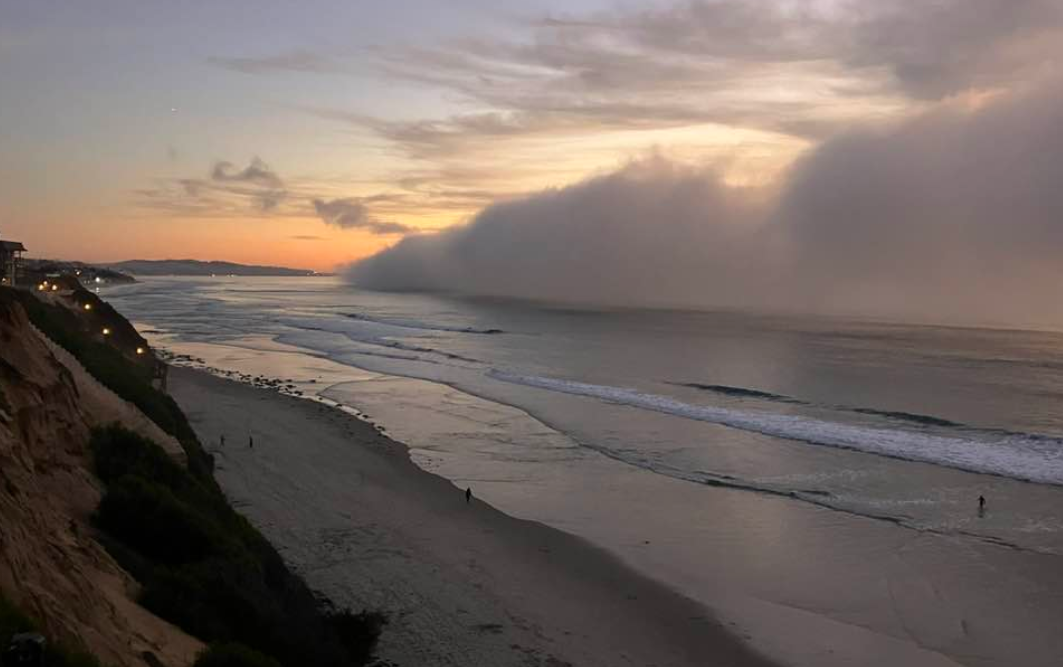 Solana Beach, California
Saeed Jones caught the feeling that one gets on seeing a fog bank when he said: “I buried myself in the bodies of other men so I could feel something other than the depression that was rolling in like a fog bank.” 
January 31st, 2024 BURLINGTON, ON
It was a comment made during a meeting of the Ontario Big City Mayors (OBCM) – Mayor Marianne Meed Ward serves is as the Chair of that organization. The remark wasn’t made during the formal part of the meeting – it was a comment made to another Mayor who mentioned what he heard to others and it eventually worked its way back to Tim Commisso.  Tim Commisso has made some very significant and positive changes to the way the city operates. A new city manager might not continue the work he started – which would be unfortunate. Commisso advised Council that he was not going to look for a renewal of his contract and will leave the City on June 10th. At the time he said he wanted to spend more time with his family. A month or more before, Council did a performance review of Commisso as a City Manager (it was done in a CLOSED session of Council). Commisso said in an open session of Council that he was humbled by the support from Council. Shortly after that Commisso was given a salary increase of $63,000 which was part of his contract. Sometime later Commisso announced that he would not seek a contract renewal. 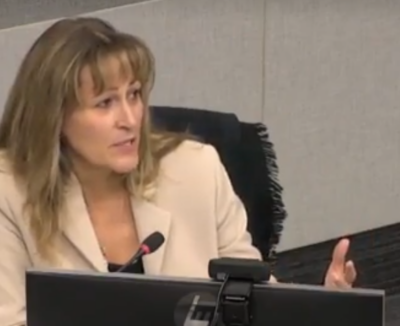 Marianne Meed Ward is not the person people elected as Mayor in 2018. Power does reveal. Meed Ward had said to another Mayor at the OBCM meeting that she was looking for a better leader, someone who would be more effective. Comments like that race through the small community of large cities – it was more than Commisso wanted to live with. His announcement that he would not seek a new contract followed. 
January 31st, 2024 BURLINGTON. ON
Favourite Classic Albums Live and its roster of A-list musicians from across the country will be performing Fleetwood Mac’s Rumours exactly as you remember hearing it, note for note, cut for cut. The single date sold out – there was the opportunity to add a date, which doesn’t happen often. Move quickly.

January 31st, 2024 BURLINGTON, ON We neglected to give credit where credit was due. The report was written by Community Development Halton. The full report, Community Data Watch, Where is Poverty in Halton, January 2024 can be found at: Community Data Watch: Where is Poverty in Halton? | Community Development Halton (cdhalton.ca) In 2020, there were over 34,000 people living in poverty in Halton. There were about 7,300 individuals living in poverty in Burlington’s 47 census tracts. Nearly 80% of the census tracts had less than 215 individuals. The other 20% of census tracts were with poverty population level ranging between 216 and 450 individuals. Almost half (49.7%) of the people living in poverty re-sided in Oakville, followed by Burlington (21%), Milton (21%), and Halton Hills (8%) A census tract (CT) is a small, relatively stable geographic area that usually has a population of between 2,500 and 8,000 persons.4 However, there is one exception, the census tract which includes North Oakville has a population of over 21,000 in the 2021 Census. This census tract has yet to be subdivided. According to Statistics Canada, a census tract may be split into two or more new census tracts (usually when its population exceeds 8,000). Halton’s poverty rate as measured by Canada’s official poverty was 5.9% compared with the provincial average of 8.3%. The measure used throughout this article is the Market Basket Measure  The amount of income needed to be above the poverty line. The graphic provides detail on the poverty threshold, or the minimum level of income deemed necessary for a basic standard of living, using the Market Basket Measure, Canada, and Ontario’s official poverty measure. The intention of this spatial analysis of data is to provide further insights into the dynamics of poverty and its impact on both individuals and the community. It raises public awareness on income and social inequalities, and serves as a communication tool to facilitate community discussions, gather input from residents, and involve them in the decision-making process regarding the types of services needed.
The map shows the number of people living below the poverty line by census tract (outlined in purple) in Halton. In the 2021 Census, there were 131 census tracts in Halton of which three were non-residential areas. Community organizations can use the geographic data to design or update existing community development programs and services especially where proximity and accessibility are important. This enables them to focus on areas with the greatest need and engage with residents to develop effective solutions. It can foster partnerships with local organizations, businesses, and government agencies to pool resources and expertise to alleviate poverty. See the following for more information on poverty in Halton and how it is measured: Community Development Halton, Our Halton, Income Statistics Canada, Census Tract: Census tract: Detailed definition
January 30th, 2024 BURLINGTON, ON  Making sure children are happy is a large part of every baby sitting assignment. Finding trustworthy childcare is a common challenge faced by many busy parents. Coordinating schedules, ensuring safety, and making sure children are happy can feel like a tricky balancing act. Whether you’ve just moved to the neighbourhood or need a date night, the quest to find the ideal babysitter in Burlington is a narrative many families can relate to. Within our close-knit Burlington community, there’s a growing trend to connect with caregivers using more modern, personalized approaches that integrate the convenience of digital platforms with the traditional values of neighbourhood care. Building trust in Burlington’s childcare network It isn’t just baby sitting – it can include caring for an older child and being able to play with them. For parents in Burlington, nothing is more critical than the safety and well-being of their children. As such, parents are seeking out caregivers who are not only skilled and responsible but who also come with a seal of approval from the community. Word-of-mouth recommendations, detailed profiles, and the ability to read reviews from other local parents are essential factors when navigating the childcare scene. These components help establish a reliable network of caregivers, giving parents that all-important peace of mind. Whether it’s a last-minute emergency, an irregular work schedule, or the need for a regular sitter, evaluating trustworthy options lays the foundation for a robust childcare community. The nourishing touch of personalized care A good baby sitter understands what interest a child and does more than spending time on their cell phone. Today’s parents aren’t just looking for someone to watch their kids; they’re looking for a babysitter who can contribute positively to their children’s development. A great caregiver can become like an extended family member, someone who fits seamlessly into the family’s routine and values. Parents often seek a sitter who can provide more than just supervision – someone who can tutor, inspire hobbies, or share a particular language or cultural background. In Burlington’s diverse community, finding a babysitter who can offer an enriching, consistent presence is as fulfilling for the child as it is reassuring for the parent. Modern childcare embraces flexibility as babysitters, now part of the gig economy, enjoy adaptable schedules, providing Burlington parents with diverse options to accommodate their varying needs. Whether university students seeking extra income or experienced nannies creating a niche, this evolution in childcare workers is reshaping caregiving in our community. Customized care for Burlington’s unique demands Knowing what to check for while taking care of a young child. In the search for babysitters, parents in Burlington appreciate a tailored approach that accommodates the unique needs of their family life. It’s about more than just finding anyone available; it’s about synchronizing schedules and ensuring that when the time is right, the care is right too. Specialty care that aligns with the family’s lifestyle, such as caregivers experienced in managing specialized diets, offering homework support, or speaking a second language, is growing in popularity. In a city as vibrant and diverse as Burlington, personalized childcare isn’t just a luxury; it’s a necessity for families looking to thrive. 
January 30th, 2024 BURLINGTON, ON
We can now tell you quite a bit more is as to why City Manager Tim Commisso decided to quit and be able to spend more time with his family. There were a lot of questions as to why Commisso would get a positive review from Council; given to him during a CLOSED session of Council; get a significant salary increase ($63,000 a year) and very shortly after advise the Mayor and Council that he was not going to seek a renewal of his contract.  All the parts have to come together if something is going to work. There was a part that didn’t come together.
What followed was a comment made at an Ontario Big City Mayors meeting that did it for Tim Commisso. Tune in tomorrow for who said what to who that caused Tim Commisso to call it a day. Sources that will go on record don’t exist. The world of City Managers is very small – they all know each other very well and in most cases work together very well. They talk to each other but seldom talk about each other. Commisso is currently heading up a Committee of City Managers that is going through all the services delivered by the Region of Halton and trying to determine which can be down-loaded to the municipalities. Commisso leaves the City on June 10th. 
January 30th, 2024 BURLINGTON, ON
Burlington likes to recognize people for the contributions they have made to the larger community. On many occasions the same person gets recognized again and again –leaving the impression that the organization giving the reward hasn’t looked all that hard for the truly deserving. Fifty woman were nominated this year. A link to see all 50 is HERE This year the Tammy Fox has been nominated for the YWCA Halton Women of Distinction Award.
Building the audience and looking for artists that she can are more than a full time job. The lock down in 2020 shut down everything – re-opening BPAC was a delicate process that Fox managed better than many. She has found ways to bring in a wider audience and at the same time create space for performers who have not yet found their place.
The YWCA legacy of celebrating fierce women and changemakers began 48 years ago and continues today with over 1,850 women and girls having been celebrated for their remarkable achievements in their sectors and communities. Other nominees are Join in celebrating this fierce group of inspirational community leaders at the Gala on March 7th. Thursday March 7th, 2024Hamilton Convention Centre by Carmen’s 6:00 p.m. to 7:00 p.m. – Cocktail Reception Tickets available HERE 
January 30th, 2024 BURLINGTON, ON
The Ontario Legislative Standing Committee on Heritage, Infrastructure and Cultural Policy heard from two of Burlington’s city councillors and the Mayor. The Standing Committee was visiting Ontario’s eight regional municipalities: Halton, York, Durham, Waterloo, Niagara, Peel, Muskoka District, and Oxford County and their lower-tier municipalities for their views on the provincial governments review. Paul Sharman has this to say: It’s a pleasure to be here. My name is Paul Sharman. I’m a ward 5 councillor for the city of Burlington in the region of Halton. I am also the deputy mayor of strategy, budget, process and performance, and president of Halton Community Housing Corp. 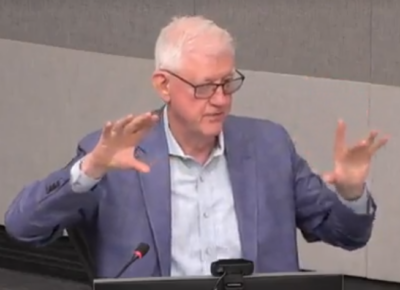 Councillor Paul Sharman: I reorganize corporations. I’ll just take, very quickly, a few seconds to describe why I’m here and the perspective that I will offer you. I have been an elected official for 13 years now. I’ve won four elections. But I’m an accountant; I’m a management accountant. I’ve operated as a controller at Nortel and other companies but, more importantly, I ran a consulting firm—and still do—for 30 years. What I do is reorganize corporations, including some very large corporations. The Canadian government has been a client of mine. I’ve reorganized companies like US West, Kellogg and many corporations like that. My perspective in what I’m about to say is that of a consultant, somebody who reorganizes corporations. I’ve spent many years focusing on downsizing, many years on process redesign, and many years on economic analysis and activity analysis and performance measurement. I take none of this discussion lightly. I’ll start off by saying that I have some general organization performance observations of all levels of government, but whatever I’m saying here especially relates to the building of new homes and the required future amenities and infrastructure, because it’s not just about housing. We cannot just have rows and rows of houses like chicken coops. It’s not the right answer. We have to make sure we think holistically about the needs of the community. Burlington is one of the few communities in Canada, or, in fact, North America, as a result of the work we’ve done, that has a 25-year strategic planning horizon for the community. It’s not about getting elected officials re-elected. We need to change our thought processes to think about the future of our communities. That said, what I can tell you is the following quite quick statements: The first thing is all levels of government function in a highly siloed fashion—barriers around everything. There is much fragmentation of work within those silos. People drop work; they get redirected. In our own planning department, we do these things called refilings, because anything we can find to trip up the applicant, to send it back and keep them waiting for another year, we do. We’ve got so much work, we’ve got so many bylaws, and we have such complexity at every level of government, it stops us from being effective. 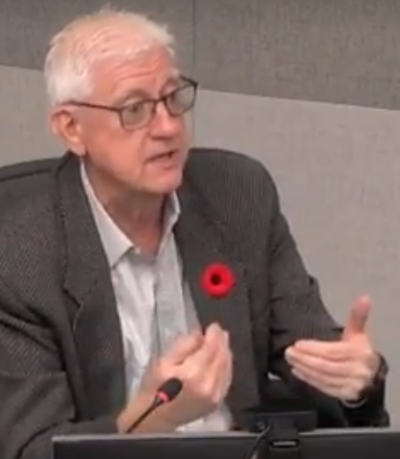 Councillor Sharman: “We have poorly designed processes.” We have commenting agencies who are disconnected when dealing with our applications—45 of them. There is significant duplication of work between Halton and Burlington, for example. Why is that? Why don’t we actually plan our processes holistically from the province right the way through down to delivery of housing, instead of just having these disconnects which exist dramatically everywhere? We have poorly designed processes—I don’t even think we have designed processes in government; they’ve evolved, just like they do everywhere. But unless you design them, they’re not going to work effectively. We have inadequate focus on the future. We’re thinking about just the last five years or the next five years, but now we’re talking about millions of people coming in the next 30 years. When do we get our brains around redesigning government and all the infrastructure we need to make that happen? We’re not there. We haven’t done that. We have lack of clarity around purpose. We don’t have clarity around performance expectations at every level. They’re not aligned. We don’t have a 30-year, 25-year strategy for Ontario. When are we going to do that? Because how do you expect anybody to deliver if we’re fuzzy and coming up with hare-brained schemes that we then reverse? It’s because we haven’t been sophisticated, we haven’t thought it through. Inadequate understanding of roles and responsibilities relative to community at all levels, from strategy through process through services through activities and through KPIs—it’s not put together. How do we do it? How do we get anything done? How can we possibly expect to get speed in delivery of needed homes and services and infrastructure if we can’t even get our brains around how to make it go seamlessly from one level to the other and make it work? We don’t do that. Finally, consequently, all the activities I see are hugely inefficient, hugely ineffective and very wasteful of taxpayers’ money. We can do better, and this is the room where I think you can influence it. So, what works in the region? I can tell you. The first thing I’ll say is the employers at all levels of professions are impressive in many ways. I truly appreciate their professionalism, their patience and desire to be supportive of elected officials and regulations.  Councillor Sharman: “I don’t like being told what to do. “ Operations in the region of exclusively controlled spheres which are mostly controlled by the province seem pretty good. But, actually, I don’t like being told what to do, because we have to have carriage of the buildings that we’re going to do in Burlington, so we need to say to other regions what we’re going to deliver, what we want them to deliver to us, not the other way round. I’m being consistent with the mayor’s thought process. What doesn’t work well is—well, I’m going to start off with a statement, and you can believe this or not. You can take it as you like. My belief is as region decisions are made, the only democratically elected representatives of any lower-tier municipality are the councillors of that lower-tier municipality and the region chair. Other members do not represent the interests of any other lower-tier municipality other than their own. That causes difficulties around that region table that we don’t need, which is why I’m supportive of the notion—absolutely no amalgamation. But, furthermore, I want to give carriage to the lower-tier for everything, because it gets in the way when we find regional people saying, “Well, we’re in charge. That’s the way it will be done.” For example, we’ve got this open sewer running through the middle of Burlington called the QEW – but we can’t get control of the access and egress of that road during peak hours when that sewer blocks up and it spews all into our city roads. We talked to the province, and what’s the answer? “Oh, well, you should just, you know, have no parking requirements with high-rise towers.” I am a long way from finished with this conversation. I have more to say. It’s all in the materials I’ve left with you, and I’ll be more than happy to have a conversation with any and all of you at your wish. Thank you. Sharman certainly wasn’t pulling his punches. The Legislative Committee was hearing what Burlington residents have heard for the past 12 years. Once each of the three made their seven minute address they were asked questions by the members of the Standing Committee that was made up of MPP’s who were part of the government and MPP’s who were part of the NDP opposition. 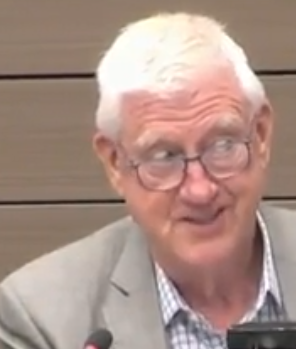 Standing Committee member Mary Margaret McMahon told Sharman: “…this has got to be the most energetic and frank comment. I appreciate your candour. Honestly, you just tell it like it is.” Expect to see these comments in Sharman’s campaign literature in 2026 Ms. Mary-Margaret McMahon MPP for Beaches in Toronto said: “I have to say that your panel has got to be the most energetic and frank. I appreciate your candour. Honestly, you just tell it like it is.” Mme Dawn Gallagher Murphy had a specific question for Sharman. ” I noted in your comments you talked about the complexity of all levels of government. You talked specifically about duplication of work. As it pertains to building more homes, could you give me a specific example of where duplication of work comes in that is perhaps preventing Burlington from making sure more homes can get built? Mr. Paul Sharman: Sure. As you will know, there are different groups or organizations involved with approving the applications: the region, Conservation Halton and the city of Burlington. What happens is, they all take their time, and they all have their own rules and their own bylaws and all the rest of it. We can just do it all at the city. The duplication is that we’re going through the same administration process of getting an application, trying to review it, looking at our rules and suggesting it could be done as a single stream within the city of Burlington. Mme Dawn Gallagher Murphy: From a regional perspective, does that mean the region should not be involved in that—that you can do it yourself? Mr. Paul Sharman: In my general view, the answer is that we should do as much as can be done at the lower level as possible. The thing that may not be recognized here and that contributes to why we have very low starts in housing is because we’re built out; we have no greenfield. The fact that the planning regime uses things called BPE, which is rear-view mirror looking, and it was never considered that we would actually be requiring to grow—it was only on November 8 that we found out we were going to have, actually, 70,000 more people. And then when the province—and we were very pleased—converted those lands to mixed use, 700 acres, it gave us the opportunity to have some growth and have a future. But the fact is, there is no analysis that deals with anything other than planning code and official plans. There is no consideration of the social benefits of development. There is no triple bottom line, and there is no win-win-win. So the fact of the matter is, we are not thinking holistically. We are not thinking about our future. We need to be out there—30 years—looking at the mix of people coming here, because there’s going to be huge numbers of people from the subcontinent and from Asia, and they will not be used to the things that we wouldn’t have because we don’t have the land. We actually have to think about it now, because otherwise we’ll keep doing what we’re doing right now, in chunks of five years, and it will just be more of the same old, row after row after row. So we have to take action now. Ms. Mary-Margaret McMahon, a Liberal member said she was “ going to start with Paul, the most frank person I’ve met yet—love it. You were talking about us not being forward-thinking and planning for the future, and I agree. I’m a big environmentalist; that’s why I got back in this nutty world, let’s say, and I’m very worried about the lack of climate action. We’ve been told by our Financial Accountability Officer about the high cost of inaction for building resilient infrastructure. If you could think of one thing for sure that is forward-thinking and acting now or yesterday, what would that be? Mr. Paul Sharman: I’m a data freak, and I’d start off with the numbers. I hear a lot of ideological arguments about save the grass blade, save the world. I think that is uninformed. I also believe we need environment care.  Councillor Sharman said: “It was never considered that we would actually be requiring to grow—it was only on November 8 that we found out we were going to have, actually, 70,000 more people. I just think we’re not having balanced conversations about what the real situation is and what has to be accomplished. The aging community leaves us in a place where we can’t have babies enough to fill jobs. We can’t find housing because everybody is getting older and not dying. So we actually have to look out 30 years and ask ourselves who needs to be here, how we’re going to get them, how we’re going to look after the environment and what social benefits of development we’re going to provide, including all the infrastructure. And do some planning at the province level, please. That was it. Burlington made its case. Mayor Meed Ward made it very clear that Burlington did not want to become part of what she feared was going to be the City of Halton. She said: “This is the Burlington council position. We have unanimously endorsed a resolution that: —we are open to consideration of all feasible governance options except amalgamation to a mega-city of Halton; —governance changes should be supported by local-tier councils, based on community engagement, and should deliver better services quicker and faster; and —needed community infrastructure is funded through development charges or senior levels of government. “Local government is the closest to the people. We understand the needs of our community. We do not need an imposed solution from any other level of government. Our community really doesn’t care who’s delivering the services as long as they’re delivered well. ” We would like the province and the federal government to provide us with the funds we need to get the job of building new homes done.” Burlington made the point that they could do much of the work the Region currently does, but realized is as well that there are tasks that have to be done on a Regional basis. Providing the drinking water and waste water management, or is as Mayor Meed Ward put it – Taps to toilets should be regional. Transit, which is now run by the municipalities could, and should be run Regionally. Roads, storm water management and, obviously, drainage. The Standing Committee will complete its road trip and then debate and discuss what they want to present to the Legislature. This isn’t going to happen in a few months – it could be is as much as a ear before there is a report. The last time the province looked at the municipal; structure NAMES toured the province, spent a day at the Region listening to what each municipality and prepared a report. That report was never made public. The report the Standing Committee makes will be public and that is about all that can be said at this point.

January 29th, 2024 BURLINGTON, ON
An update on the washrooms in the John Street Transit Terminal. There will be no public washrooms. Here is what we got from City Communications earlier today: The washrooms in the John Street Burlington Transit Bus Terminal were closed to the public during the COVID pandemic. The facilities will continue to be for staff use only to ensure transit staff are able to take their health breaks and not impact transit service, in a safe and clean facility. Public washrooms are available nearby in Sims Square, 390 Brant St., main floor (170 metres away) and Burlington City Hall, 426 Brant St., lobby (300 metres away). Something isn’t quite right here. There were two public washrooms before Covid. When Covid changed the way we lived, the city made one of the two washrooms a Unisex washroom and one for Staff only. That seemed reasonable
The Gazette contacted the City Communications department and learned that the current status: Both washrooms would be for Staff only when there are just two people working at the transit station. We kept having to get back to the Communications department. In a recent survey on how people felt about the services the city provides it became clear that Burlington is a car centric city. For people who have to use public transit who need to use a public washroom – tough luck. The Director of Transit operations is reported to be holding a meeting at St. Luke’s Anglican Church on on Wednesday.

January 29th, 2024 BURLINGTON, ON
It was not a good week for Premier Ford. The Greenbelt scandal is the kind of thing that defeats a government. It is complex – when the matter has $7.8 billion attached to it – you can bet that it is complex. The more complex the facts are the harder it becomes for people to understand just how bad the issue is. Behind all the revelations is the RCMP investigation. If they decide that there was criminal behaviour and charges are laid – it doesn’t really do very much other than make the mess smell even worse. The Conservatives have a clear majority in the Legislature – and the next election is not until 2026 – plenty of time for the public to forget what is admittedly very complex. Bonnie Crombie is expected to be an MPP in the not too distant future which will mean Ford will have to women hammering away at him every day. 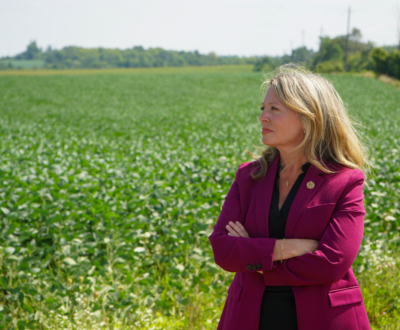 NDP leader of the Opposition Marit Stile standing in a field that was taken out of the Greenbelt lands and made available for development. Marit Stiles, the NDP leader of the Opposition dropped another clutch of email traffic that she obtained through a Freedom of Information application related to email that was sent on computer servers that were not part of those that are operated by the government. Politicians and government staff are required to use the equipment the government provides. Stiles made what she found public and the Toronto Star was all over the material – that was more than revealing. Stiles maintained that the Premier was not truthful when he met with the Integrity Commissioner. Recall that it was the Integrity Commissioners’’ report that led to the resignation of the then Minister of Municipal Affairs and Housing and the decision on the part of the government to roll back the decision it made to approve development on land that was within the Greenbelt boundaries. Emails obtained in response to a Freedom of Information request suggest a timeline that is inconsistent with the testimonies provided by Ryan Amato and Patrick Sackville under oath, and that the Premier’s office knew about the land swaps much earlier than they claimed. “This e-mail shows that the Premier’s office was far more involved in the Greenbelt land removals than Mr. Ford claimed” said Stiles. “The Conservatives are trying desperately to make this scandal go away, but it is becoming increasingly clear that they cannot hide from their corruption. “With each new piece of evidence, we are seeing more cracks in the narrative that the Premier and his insiders have been trying to spin. But the truth is becoming clearer every day – Mr. Ford was not in the dark about his government’s corrupt Greenbelt decisions.  Premier Ford in conversation with Steve Clark while he was still a member of Cabinet. “It’s time for the Conservatives to come clean about how they deceived Ontarians with this Greenbelt fiasco. If they don’t, I’m confident the RCMP will.” At issue is an Oct. 17, 2022 email exchange — on their private accounts instead of on government servers — between Patrick Sackville, then the premier’s principal secretary and now his chief of staff, and Ryan Amato, at the time the top aide to then-municipal affairs minister Steve Clark. In a message from Amato to Sackville that day, (October 17th) the ministerial chief of staff shared a “list of criteria for removals” of 7,400 acres from the two-million-acre environmentally sensitive Greenbelt around the Greater Toronto and Hamilton Area. These include “infrastructure services,” such as nearby roads, gas and water mains, hydro lines, police and fire services, among other things. It also listed “potential offsets” such as the Paris Galt Moraine “green space our government has decided not to move on” and “options to go larger depending on executive interest.” The timing of the email is at odds with testimony made under oath to J. David Wake, the Integrity Commissioner, for his August 30 report on the Greenbelt land swap. “Members of the premier’s staff also told us they were not involved in the selection of properties,” wrote Wake. “Mr. Sackville said he did not discuss specific properties to be removed or removal criteria with Mr. Amato until the briefing that occurred on October 27, 2022,” the ethics watchdog continued. “Mr. Sackville recalled being first briefed about the Greenbelt project at a meeting facilitated by the cabinet office on October 27, 2022. He told me that he recalled the intentions of the policy were discussed and that it should be ‘programmatic,’ meaning that it should be something that could be repeated and made standard.” But that was 10 days after the Oct. 17 email in which criteria for removal of the lands from the Greenbelt was addressed. Clark announced the changes on Nov. 4, 2022. “This email … shows that the premier’s office was far more involved than Mr. Ford claims in the selection of Greenbelt lands for removal,” said NDP Leader Marit Stiles.  Premier Doug Ford – the evidence now available suggests some of the statements the Premier made to the Integrity Commissioner were not the truth. “Conservatives very much want their Greenbelt scandal to go away, but it is glaringly clear they can’t hide from what they’ve done,” said Stiles, who has asked Wake to “provide an opinion on whether it is consistent with Mr. Sackville’s testimony to your office under oath.” “With each new piece of evidence, we are seeing more cracks in the narrative Mr. Ford and his insiders have been trying desperately to get people to believe — that Ford was in the dark about this scheme to carve up prime farmland and green space for land speculators,” she said. Last week, the integrity commissioner advised Stiles he would “need some time to review the evidence, not only of Mr. Sackville, but other witnesses to determine whether there was an inconsistency in the evidence.” “If I determine that there was an inconsistency, I will provide you with my opinion as to what, if any, significance might attach to it. I will get back to you as soon as I have had an opportunity to review the matter,” Wake wrote her on Jan. 15. But the email was shared with the NDP by cabinet office lawyers as soon as the now-chief of staff, who receives hundreds of messages daily, found and forwarded it. “This record was just discovered upon deeper review,” Sackville wrote Dec. 20 to cabinet office general counsel Don Fawcett. Two days later, it was handed over to the New Democrats, who had filed a freedom of information request months earlier.  Patrick Sackville, former principal secretary and current chief of staff to the Premier. “To ensure all necessary due diligence was exercised, Patrick Sackville … conducted additional searches within his personal email account,” wrote Janet Dadufalza, senior freedom of information manager in cabinet office. “From this search, an email that is considered to be responsive to your request was found. Partial access is granted,” she wrote the NDP on Dec. 22. But “access to the remaining record continues to be denied” because of cabinet privilege. It is unclear why personal email accounts were being used to conduct official government business. Amato Ford- government staffer at the centre of greenbelt controversy resigned on August 22. Clark, who remains the MPP for Leeds-Grenville-Thousand Islands and Rideau Lakes, quit Ford’s cabinet on Sept. 4. Through his lawyer, Kathryn Marshall, Amato declined to comment. Ford has insisted he was out of the loop about the removal of 15 parcels of land from the Greenbelt that the auditor general estimated would be worth $8.28 billion to property owners. “I had nothing to do with the changes in the Greenbelt … the auditor general cleared us, cleared my office, and the integrity commissioner cleared me and my office,” he premier said October. 31. In separate reports last summer, the Auditor General and Integrity Commissioner found certain developers with Tory connections were “favoured” in an unusual process supposedly led by Amato. On Sept. 21, an embattled Ford finally cancelled the land swap, which is now being investigated by the RCMP. “It was a mistake to open the Greenbelt. I’m very, very sorry,” the premier said that day. “I made a promise to you that I wouldn’t touch the Greenbelt. I broke that promise. As a first step to earning back your trust, I’ll be reversing the changes. We moved too quickly and we made the wrong decision … it caused people to question our motives.” Other casualties of the imbroglio were Kaleed Rasheed, who was forced out as Ford’s business minister and turfed from the Progressive Conservative caucus last September, and Jae Truesdell, who was Ford’s housing adviser. Rasheed and Truesdell were on a controversial 2020 trip to Las Vegas with Greenbelt developer Shakir Rehmatullah and Amin Massoudi, who was the Premier’s principal secretary at the time. 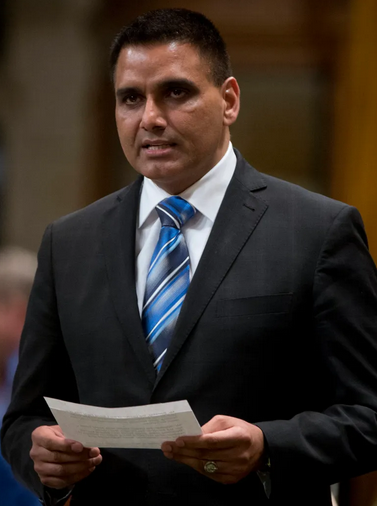 Parm Gill, MPP for Milton and member of the Ford Cabinet resigns. Some of northern Burlington is in the Milton riding. Last week Cabinet Minister Park Gill resigned to run as a federal Conservative. The Legislature will return to Queen’s Park February 24th. Who did what and when: Patrick Sackville (former principal secretary and current chief of staff to the Premier) and Ryan Amato (former chief of staff to the former Minister of Municipal Affairs and Housing) exchanged information including “list of criteria for removals” of 7,400 acres of the Greenbelt These emails were exchanged 10 days before the dates that Amato and Sackville provided to the Office of the Integrity Commissioner in a testimony made under oath Amato and Sackville used their personal emails to exchange information about public policy instead of their government emails Using personal email for conducting government business does not exempt one from the Freedom of Information and Protection of Privacy Act, as outlined in the Auditor General’s special report on the Greenbelt land removals which saw recurring use of personal emails by government staff 
January 29, 2024 BURLINGTON, ON
Speaking before the Standing Committee on Heritage, Infrastructure and Cultural Policy earlier this month Mayor Meed Ward laid out the development numbers for Burlington, She said:  Mayor Marianne Meed Ward was one of three members of Council appearing before the the Legislative Standing Committee. “We have over 40,000 units in our development pipeline. Our target is only 29,000, but we’re not going to stop at that; we’ll keep building as long as people need a home. “There are 7,500 at the tribunal; “2,770 are waiting for the development industry to come in and apply for a site plan; “7,972 are under review—that is the municipal permit process—and 3,940 have already been approved. “We’re just waiting for developers to come in and get a permit. Why aren’t they? That would be a really good question for you to ask them. “Another 18,541 are in the pre-application stage. That’s the hope-and-a-dream stage, where somebody owns a piece of property and they come in and they say, “I might want to do something with it. What can I do?”  A development on Waterdown Road in the western side of the city that has appealed to the Ontario Land Tribunal for a decision. “Many of those —not all, but many of those do turn into a permit, but that’s where it starts.” Later in the day Meed Ward spoke about why development application are at the Ontario Land Tribunal (OLT). Asked by Mr. Matthew Rae. a member of the Legislative Committee: “Is it true that the city of Burlington is appealing a lot of those? Did they send them, or with their support, to the tribunal?”  “ Ms. Marianne Meed Ward: “No, actually. Those are appealed often by the developer for the time it takes to develop applications. As Councillor Sharman said earlier, we’re not doing greenfield development in Burlington. It’s highly complex infill development: major, 30-storey, five, six, seven towers in one area. The kind of review that is required doesn’t happen within the 120 days. Often, the information we need from the applicant, we don’t even get within the 120 days. And there is no recognition or change between that and a much smaller two semi-detached units. It’s 120 days, that’s it, and shortened very recently. “We get appealed for non-decision because developers want to get their name in the queue early. That is why they’re going there, because often we get—they told us, “We want to continue working with you to get an answer, but we need to get our spot at the OLT, so we’re not going to wait another three or four months for you to get the decision that is probably the right one. We’re going to put our name into the OLT.” Well, that stops everything, and that just adds another two years to the time frame for getting an approval because of the delays at the tribunal, because of the de novo changes, that you reset back, where everything starts at the very beginning again as if there had been no review. “So all of our work, that happens at a local level, it’s gone, and it starts all over again with experts and submissions. And one tribunal person, not elected, appointed by the government, makes that decision.”

January 28th, 2024 BURLINGTON, ON
Parm Gill, the Conservative member of the provincial legislature has resigned and announced that he will run for the Milton federal seat.  Parm Gill decides the House of Commons is a safer place than Queen’s Par,k – chooses to leave the Ford government. Has Gill come to the conclusion that the Ford government is toast and has decided to look for greener grass? Political pundits think the riding might be a good place for Provincial Liberal Party leader Bonnie Crombie to run for office. The Premier has six months to call a by-election – that would result in a summer election in Milton. The Milton constituency includes some of the northern part of Burlington. Bonnie Crombie shouldn’t expect anything in the way of support from Milton Mayor Gord Krantz – he is as blue blooded a Tory is as they come.  Is Bonnie Crombie eyeing the seat in Milton that will become available? Crombie could sweet talk Krantz into being neutral – he has done that in the past. Milton has a solid federal candidate in Adam van Koeverden – he and Crombie would be very capable campaigners. Could be interesting – something to keep an eye on while we wait for Crombie to decide what she wants to do. Wherever she runs – she has to win – it has to be a solid win, 
January 28th, 2024 BURLINGTON, ON First in a series In August 2022 Public Service Canada published a lengthy report on Flood Insurance and Relocation. The Executive Summary of the report set out four subject areas that were focus points Executive Summary A Task Force to Explore Insurance Solutions A Shared Evidence-Basis for Decision-Making Key Findings of the Task Force Living with Water In August of 2014 the City experienced a devastating flood in the eastern part of the City.
By 2024 most of the world had come to the realization that we were dealing with a crisis and that not everyone was on board. The report set out, to some degree, what water means to Canadians. Four out of the five Great Lakes lie between the United States and Canada. They are Lake Superior, Lake Huron, Lake Erie, and Lake Ontario; the only Great Lake that does not border Canada is Lake Michigan. The foreseeable future suggests that Canadians must learn to live with water. Yet, the country cannot do this at the expense of safety, fiscal responsibility, or equity. It is clear from this work that flood insurance solutions for high-risk areas can be designed to meet the Public Policy Objectives; however, each model examined contains trade-offs that must be balanced. It is also apparent that given the amount of flood risk in Canada, none of the insurance models can provide affordable insurance and also be financially self-sufficient, at least in the short term. Even over a longer-term (25 year) transition to risk-based pricing, financial sustainability will continue to be challenged by inflation, significant asset concentration in flood-prone areas, and long-term climate change pressures. 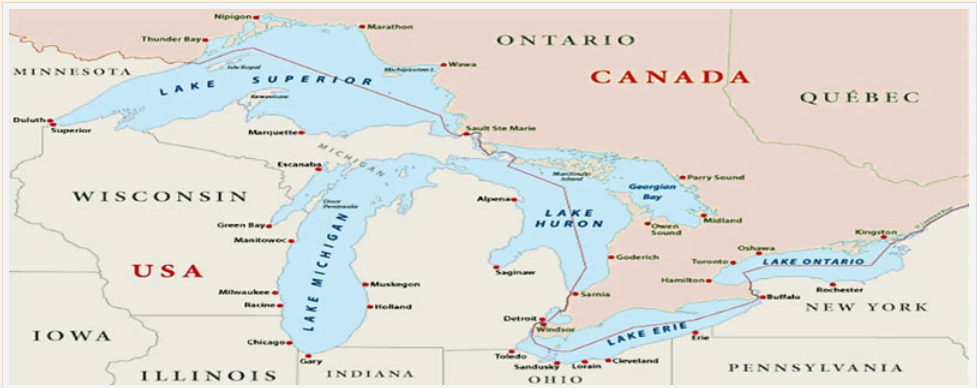 The Canada United States border is shown as a thin red line Consequently, to live with water, Canada will require more than an insurance solution to address its flood risk landscape. Insurance must be deployed in conjunction with information, investments and incentives at all levels that are designed to reduce flood risk. Such elements include: improved flood mapping and public awareness of flood risk, risk reduction by all stakeholders, improved land-use planning, and climate-resilient built and natural infrastructure. In addition, for an insurance solution to be successful, recovery funding provided to residential properties for flooding though FPT disaster financing programs would need to cease or be restructured to avoid undermining the insurance system. This is an important step towards aligning responsibilities for flood risk. The findings in this report are meant to provide governments with the foundation to understand the different policy levers and key considerations to be factored into decision-making, and to ensure that any insurance solution strives to effectively meet the defined policy objectives and serve all Canadians impacted by flooding. Particularly, it is important to consider policy options that account for the populations that are disproportionately affected by floods and have lower levels of resiliency to cope with them. Continuing to advance this work will require coordination and commitment from each stakeholder to exercise their jurisdictional role and develop a way forward for implementation. The collective challenge will be to not let the perfect be the enemy of the good, thereby preventing the implementation of a solution that could nonetheless dramatically improve upon the status quo for Canadians who remain at high risk and who continue to experience tremendous loss from ever-increasing flood events. A new approach to flood insurance will not solve all vulnerability to flooding. However, with a strong stakeholder commitment and decisive action, it could play an important role in empowering Canadians to adapt to flood risk, and building disaster resilience across our nation. . In recent years, the gap between insured losses and total economic losses has also widened significantly. In 2020, this “protection gap” widened to a record $231 billion worldwide, with around 75% of potential global losses from natural disasters remaining insured with insufficient coverageFootnote 7. The consequences of this are already being experienced across Canada, where disaster costs have risen dramatically in recent years. Before 1995, only three disasters in Canadian history exceeded $500 million (2014 dollars), but from 2013 to 2017, Canada had disaster losses totaling $16.4 billion. Prior to 2009, insured losses from catastrophic severe weather averaged $400 million per year; since then, the annual average has reached $1.4 billion.  The 2014 flood centered on the creeks that were not built to handle the flow of water: The trajectory of disaster trends poses significant risks to the health and well-being of Canadians, the economy, and the natural environment. Governments and other stakeholders must continue to work together to address the growing impacts of disasters. In 2019, the federal, provincial, and territorial (FPT) governments approved the Emergency Management Strategy for Canada: Toward a Resilient 2030 (EM Strategy), which provides a long-term, strategic vision for emergency management in Canada that is aligned with the United Nations Sendai Framework for Disaster Risk Reduction. The Emergency Management Strategy seeks to guide federal, provincial, and territorial governments and their respective EM partners (including but not limited to: Indigenous peoples, municipalities, communities, volunteer and non-governmental organizations, the private sector, critical infrastructure owners and operators, academia, and volunteers) to build resilience through five priority areas for action: Enhance whole-of-society collaboration and governance to strengthen resilience; Improve understanding of disaster risks in all sectors of society; Increase focus on whole-of-society disaster prevention and mitigation activities; Enhance disaster response capacity and coordination and foster the development of new capabilities; and Strengthen recovery efforts by building back better to minimize the impacts of future disasters. Priority 3 includes as a priority outcome that “FPT governments assist in the development of options for sharing the financial risk of disasters”, which could include “engag[ing] the private sector to develop an affordable private flood insurance model for the entire population, including clear incentives for mitigation of flood risks”.  Flooding – up front and very personal. In Canada, recent efforts to reduce disaster risk have focused in large part on flooding, given that it is the country’s most common and costly natural disaster. Flooding has caused approximately $1.5 billion in damage to households, property and infrastructure in Canada annually in recent years (approximately $700 million in insured losses and $800 million in uninsured losses), with residential property owners bearing approximately 75% of uninsured losses each. Several million homes in Canada are vulnerable to flooding, and many cannot access adequate insurance to protect themselves. These households must rely on their own resources or limited post-disaster financial assistance from governments or not-for-profit groups to recover from flooding events, which do not fully compensate for all financial losses. The report runs to 117 pages. The Gazette will cover the fundamentals in a four part series. 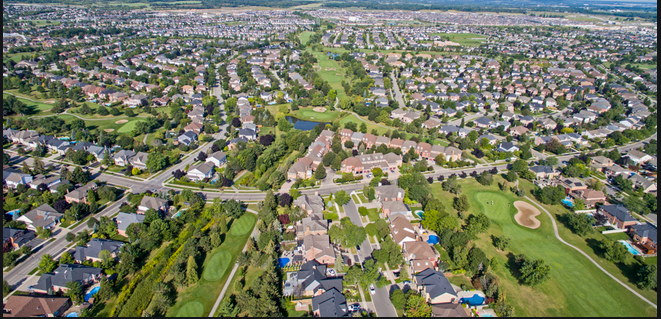 The golf course came first and included an infrastructure to manage the flooding. An additional 98 homes threatens the capacity of the infrastructure. To tighten the focus from a Canada wide viewpoint to a local issue we will frequently turn to the problem the people in the Millcroft community face. That community was built around a golf course that included an infrastructure that was designed to manage the flow of water. A developer purchased the golf course and then filed an application to build an additional 98 homes that would, in the minds of many in the community damage the infrastructure and result in serious flooding. They opposed the expansion of additional housing, city council chose not to accept the development proposal and an appeal was filed with the Ontario Land Tribunal.

January 28th, 2024 BURLINGTON, ON
The number of Canadians ending their lives through medically assisted death (MAID) has grown at a speed that outpaces every other nation in the world. The Investigative Journalism Bureau, a non-profit newsroom based at the Dalla Lana School of Public Health and the Toronto Star report that assisted deaths accounted for four per cent of all deaths in Canada in 2022 — up from one per cent in 2017, the first full year the legislation was in place. The number of MAID deaths quadrupled during that time. In 2022, the total number hit 13,000 nationwide — a 31 per cent jump from the previous year. As Canada is poised to expand eligibility criteria under medical assistance in dying (MAID) legislation, data from all 11 countries where the controversial end-of-life treatment exists shows Canada is the fastest-growing adopter in history, an analysis by the Investigative Journalism Bureau and the Toronto Star has found.
Some experts see the rapid growth as a human rights triumph that allows Canadians to make their own choice about when they wish to die with the full support of the state and their doctors. Others fear that failures in the health-care system and social safety net may be contributing to the surge. “It’s kind of like my mind’s little Holy Grail,” he said of the government’s promise of accessing a physician-assisted death. “I’ve always been living my life with one foot out the door.” 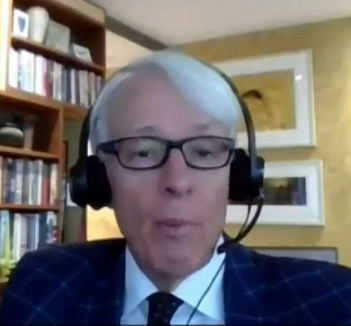 Jeff Kirby, Dalhousie University The Toronto Star reported that “Jeff Kirby, a professor emeritus in the department of bioethics at Dalhousie University in Halifax, was a member of the federal expert panel tasked by the government in 2021 with drafting safeguards for the expansion of MAID into mental health. “While he isn’t opposed to the idea, he stepped down from the panel prior to its final report in May 2022, saying safeguards suggested by experts ought to be legally entrenched rather than simply guidance. “He remains fearful that the new rules welcoming mental health patients to seek MAID lack the rigour and protection to prevent tragedy. “I really think that Canada as a whole will have lost if it proceeds to March 2024 with no changes,” he says. “I think we have lost a chance to adequately protect members of vulnerable, disadvantaged social groups in a way that we should have.” Related video: 
|
||||||||
|
Copyright © 2024 Burlington Gazette – Local News, Politics, Community - All Rights Reserved Powered by WordPress & Atahualpa |
||||||||